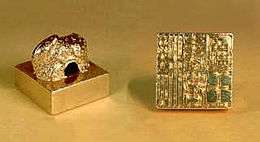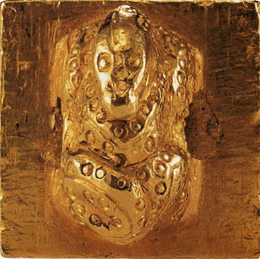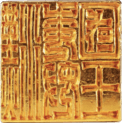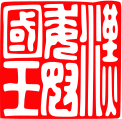King of Na gold seal
The King of Na gold seal is a solid gold seal discovered in the year 1784 on Shikanoshima Island in Fukuoka Prefecture, Japan. The seal is designated as a National Treasure of Japan.[1] The seal is believed to have been cast in China and bestowed by Emperor Guangwu of Han upon a diplomatic official (envoy) visiting from Japan in the year 57 AD. The five Chinese characters appearing on the seal identify it as the seal of the King of Na state of Wa (Japan), vassal state of the Han Dynasty.[2] The seal is currently in the collection of the Fukuoka City Museum in Fukuoka, Japan.[3]


Appearance
The seal is composed of gold of 95% purity.[4] It is made up of a square base, with the seal itself on the bottom face, and a handle on top of the base in the shape of a coiled serpent. It has a mass of 108.729 grams. The total height from base to handle is 2.236 cm. The base of the seal averages 2.347 cm on a side. This dimension roughly corresponds to the traditional Chinese standard unit of length of one cun, as used in the Later Han Dynasty (about 2.304 cm).[5]
Characters engraved on the seal
The five characters engraved on the seal are (in the order in which they are to be read):
- 漢委奴國王
The meanings of these characters (in the context of this seal) are: "Han" (referring to the Han Dynasty of China), "Wa" (an ancient name for Japan), "Na" (an ancient kingdom / state within Japan), "state / country", and "ruler". The last two characters, when combined, mean "king / sovereign". Altogether, the meaning of the seal inscription is: "(seal of) the King of the Na state of the Wa [vassal?] of the Han Dynasty".
The characters are engraved in the seal script style.
History
The seal has been judged to be the one described in the Book of the Later Han, a Chinese chronicle of the history of the Eastern Han Dynasty. According to the chronicle, the Chinese Emperor Guangwu conferred the seal on a diplomatic official visiting from Japan.
Contemporary description of conferral
The following is the original Chinese text from the chronicle:
- 建武中元二年,倭奴國奉貢朝賀,使人自稱大夫,倭國之極南界也。光武賜以印綬。[6]
This passage can be translated into English as:
- "In the 2nd year of the jianwu zhongyuan reign period [AD 57], the Na state of Wa sent an envoy with tribute. The envoy introduced himself as a high official. The state lies in the far south of Wa. [Emperor] Guangwu bestowed on him a seal with a tassel."[3][7]
During the Han Dynasty, similar seals were bestowed on other regional sovereigns, in an attempt by the dynasty to bring these sovereigns into the Han ruling order.[3]
Rediscovery

After being lost for an undetermined period of time, the seal was reportedly rediscovered on April 12, 1784, on Shika Island in Fukuoka Prefecture, Japan. According to contemporary reports, the seal was discovered by a farmer named Jinbei while repairing an irrigation ditch. It was found surrounded by stones forming a box-like structure around it. The stone above the seal required two adults to lift. After rediscovery, the seal was kept by the Kuroda clan, rulers of the Fukuoka Domain, and eventually donated by the Kuroda family to the city of Fukuoka in 1978.[3]
See also
- King of Dian gold seal
- King of Nanyue gold seal
- List of National Treasures of Japan (archaeological materials)
References
- National Treasures of Japan – Exhibition catalogue, April 10 - May 27, 1990, Tokyo National Museum (in Japanese). Yomiuri Shimbun. 1990.
- Miyake, Yonekichi (December 1892), "漢委奴國王印考 (A study of the seal [inscribed] to the King of the state of Na in Wa under the Han dynasty)", Shigaku zasshi, 3 (37): 874–81
- "Gold Seal (Kin-in)". Fukuoka City Museum. Retrieved 2011-12-24.
- "The Gold Seal, "Kan no Wa no Na no Kokuo"". Fukuoka Art Museum. Retrieved 2011-12-24.
- "金印" [Gold Seal] (in Japanese). Fukuoka Prefectural Shakaikyouiku Sougou Center. Retrieved 2011-12-24.
- "後漢書·東夷列傳第七十五" [Houhanshu Part 75] (in Chinese). Retrieved 2011-12-24.
- Tsunoda, Ryusaku (1951). Goodrich, L. Carrington (ed.). Japan in the Chinese Dynastic Histories: Later Han Through Ming Dynasties. Perkins Asiatic monographs. South Pasadena, CA: P.D. and Ione Perkins. p. 187.

